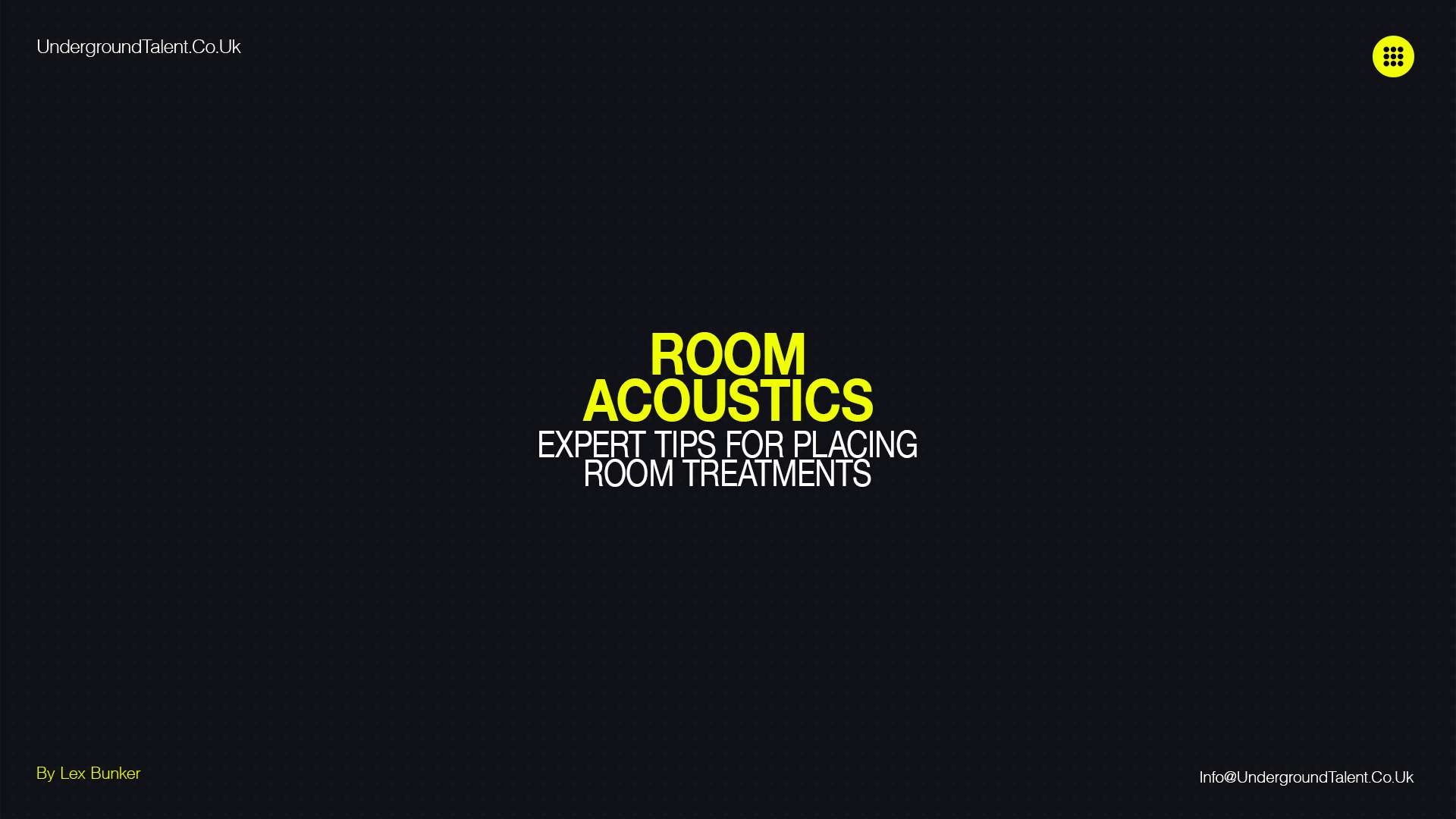How to Place Room Treatments Properly?
To place room treatments properly, start with absorbers at first reflection points on walls and ceiling. Add bass traps in corners to control low-frequency buildup. Position diffusers on back walls to scatter sound evenly. Place absorptive panels behind speakers to manage rear reflections. Hang acoustic panels or clouds on the ceiling for better sound control. Ensure rugs or carpets cover hard floors to absorb sound.
Special Focus Areas for Optimal Sound
Rear Sidewalls: Reducing Echo and Improving Clarity
Rear sidewalls can create unwanted echoes that muddy the sound. Placing absorptive panels or diffusers here can help reduce these reflections, improving overall clarity.
Back Walls: Techniques for Diffusion and Absorption
Back walls can benefit from a mix of diffusion and absorption. Diffusers scatter sound waves, maintaining room liveliness, while absorptive panels can help control echoes.
Corners: Enhancing Bass Management with Bass Traps
Corners are prone to low-frequency build-up, leading to boomy bass. Installing bass traps in corners helps manage these frequencies, ensuring a balanced sound.
Ceiling: Effective Strategies for Ceiling Treatment
Ceiling treatments, such as acoustic clouds or panels, absorb sound waves that would otherwise bounce off the ceiling. This helps reduce echo and improve sound clarity.
Floor: Importance of Rugs and Carpeting in Sound Absorption
Hard floors can reflect sound, causing echoes. Adding rugs or carpeting can absorb these reflections, contributing to a more controlled acoustic environment.
Tailoring Acoustic Treatments to Different Room Types
Small Rooms: Strategies for Minimizing Echo and Reflection
Small rooms often suffer from excessive echo and reflections. Placing absorptive panels at first reflection points can help. Use bass traps in corners to manage low-frequency build-up. Rugs or carpets on floors absorb sound, reducing reflections. This setup ensures clear and balanced sound. For more detailed guidance, check out Room Acoustics 101: Expert Tips for Small Places.
Large Rooms: Balancing Absorption and Diffusion for Even Sound
Large rooms require a mix of absorption and diffusion. Absorptive panels control echoes, while diffusers scatter sound waves. This balance prevents the room from sounding too dead or too lively. Bass traps in corners manage low frequencies. Ceiling treatments enhance sound control further.
Home Theaters: Ensuring Optimal Sound Distribution and Immersion
Home theatres need even sound distribution for an immersive experience. Place absorptive panels at the first reflection points. Use diffusers on back walls to enhance sound spread. Bass traps in corners ensure a balanced bass response. Ceiling panels or clouds control overhead reflections, improving clarity.
Recording Studios: Achieving a Balanced and Lively Sound Environment
Recording studios need a balance between absorption and diffusion. Absorptive panels at first reflection points reduce echo. Diffusers on back walls maintain room liveliness. Bass traps in corners manage low frequencies. Ceiling treatments help control sound reflections, ensuring a clean recording environment.
Practical Tips for DIY Acoustic Treatment
Affordable Solutions for Home Acoustic Treatment
Improving home acoustics doesn’t have to be expensive. Use thick curtains, rugs, and bookshelves as budget-friendly options. These items absorb sound and reduce reflections, improving room acoustics without breaking the bank.
Step-by-Step Guide to Building Your Own Acoustic Panels
Building your own acoustic panels is cost-effective and fun. Use basic materials like wood frames, insulation, and fabric. Start by constructing the frame, filling it with insulation, and wrapping it with fabric. Hang these panels at first reflection points to see immediate improvements.
Cost-Effective Alternatives to Commercial Acoustic Products
Commercial acoustic products can be pricey. Instead, consider DIY solutions or repurposed household items. Thick blankets, mattresses, and pillows can serve as temporary sound absorbers. These alternatives provide similar benefits at a fraction of the cost.
Common Mistakes to Avoid in Acoustic Treatment Placement
Over-Absorption: How to Prevent Deadening Your Room
Many people overdo acoustic treatments, leading to a deadened room. Over-absorption can make a space feel lifeless. To prevent this, balance absorptive and diffusive treatments. Use absorptive panels at first reflection points and diffusers on back walls. This strategy maintains sound clarity and room liveliness.
Ignoring Low Frequencies: The Importance of Bass Traps
Low frequencies often get overlooked in acoustic treatment. Bass traps are essential for managing low-frequency build-up. Place them in room corners to absorb excess bass. Ignoring low frequencies can result in a boomy and unbalanced sound. Proper bass management ensures a more accurate and pleasant audio experience.
Poor Placement: Ensuring Treatments are Effectively Positioned
Incorrect placement of acoustic treatments reduces their effectiveness. Identify first reflection points and place absorptive panels there. Use a mirror to locate these points on walls and ceilings. Ensure bass traps are in all corners and diffusers on back walls. Proper placement maximizes the benefits of your acoustic treatments.
Enhancing Room Aesthetics with Acoustic Treatments
Integrating Acoustic Panels into Your Interior Design
Acoustic panels don’t have to be an eyesore. Integrate them into your room’s design for a cohesive look. Choose panels that match your color scheme and style. This integration makes your space look good while enhancing sound quality.
Stylish and Functional: Acoustic Solutions That Look Good
Opt for acoustic solutions that are both stylish and functional. Many manufacturers offer panels in various designs and colors. Some even provide custom printing options. These solutions can blend seamlessly into your decor, adding an aesthetic touch while improving acoustics.
Customizing Acoustic Treatments to Match Your Room’s Decor
Customizing acoustic treatments can enhance your room’s decor. Use fabric-covered panels in colors that match your furniture. Consider artwork panels that serve a dual purpose of decoration and sound absorption. Customized treatments make your room look unique and personalized while providing excellent sound control.
Advanced Acoustic Treatment Techniques
Combining Absorption and Diffusion for Superior Sound
Combining absorption and diffusion techniques creates superior sound quality in any room. Absorptive panels reduce echoes and control mid to high frequencies. Diffusers scatter sound waves, maintaining a room’s liveliness. Strategically use both treatments to achieve a balanced and clear audio environment. This combination prevents over-absorption, ensuring that your room sounds natural and vibrant.
Using Acoustic Software to Plan Treatment Placement
Acoustic software can help plan the optimal placement of treatments. These tools simulate how sound behaves in your room, identifying problem areas. By visualizing reflections and absorption points, you can precisely place panels and traps. This planning ensures maximum effectiveness of your acoustic treatments, enhancing overall sound quality.
Professional Acoustic Treatment Services: When to Call an Expert
Sometimes, it’s best to call in a professional. Experts offer detailed room analysis and tailored treatment solutions. They use advanced tools and techniques to address specific acoustic challenges. Hiring a professional ensures a high-quality acoustic environment, especially for complex or large spaces. Invest in expert services for the best possible results.
Maintenance and Upkeep of Acoustic Treatments
Regular Cleaning and Care for Acoustic Panels
Regular cleaning extends the life of your acoustic panels. Dust and debris can affect their performance. Use a vacuum with a soft brush attachment to gently clean panels. For fabric-covered panels, spot clean with a mild detergent if necessary. Keeping panels clean ensures they continue to function effectively.
Inspecting and Adjusting Treatments Over Time
Inspect your acoustic treatments periodically. Check for signs of wear or damage. Over time, you may need to adjust their placement. Room conditions and furniture changes can affect acoustics. Regular inspections and adjustments ensure your treatments remain effective and adapt to any changes in your space.
Upgrading Your Acoustic Treatments for Better Performance
Upgrading treatments can significantly enhance performance. New materials and technologies offer improved sound absorption and diffusion. Consider upgrading if your current setup isn’t meeting your needs. Advanced options like adjustable bass traps or modular panels can provide better control and flexibility. Upgrading keeps your acoustic environment at its best.
Frequently Asked Questions about Room Acoustics
How Do I Know if My Room Needs Acoustic Treatment?
If your room has echo, reverberation, or unclear sound, it likely needs acoustic treatment. Clap your hands and listen for echoes. If you notice a prolonged sound, acoustic treatments can help. Rooms used for recording, home theaters, or music listening benefit significantly from proper acoustic treatment.
What’s the Best Material for Acoustic Panels?
The best materials for acoustic panels are dense and porous. Fiberglass and mineral wool are popular choices due to their excellent sound absorption properties. Foam panels are also effective and more affordable. Choose materials based on your specific needs and budget for optimal results.
Can Acoustic Treatments Really Make a Difference?
Yes, acoustic treatments can significantly improve sound quality. They reduce echoes and reverberation, enhancing clarity and balance. Proper treatments make a noticeable difference in recording studios, home theatres, and even regular living spaces. Investing in acoustic treatments is essential for achieving high-quality sound.
Conclusion: Achieving Perfect Room Acoustics
Effective acoustic treatment involves placing absorptive panels at first reflection points and using bass traps in corners. Combining absorption and diffusion ensures balanced sound. Proper placement maximizes the benefits of your treatments, creating a clear and natural sound environment.
Experiment with different placements and combinations of acoustic treatments. Adjustments may be needed over time as your room’s layout changes. Regularly testing and tweaking your setup helps maintain optimal acoustics. Don’t be afraid to try new configurations to find the perfect balance.
Creating an optimal sound environment enhances your listening and recording experience. Proper acoustic treatments make a significant difference in sound quality. By understanding and implementing effective strategies, you can transform any room into an acoustic haven.
Related Articles
Additional Resources
- Mixing Electronic Music: Fundamentals and Objectives
Electronic Music Promotion – Unlock Massive Growth with Hypeddit
Producing Techno? Get Your Free Sample Packs.
Dive into electronic music production with our newly released “Free Techno Tools V1” and “Free Techno Tools V2” sample packs. These packs are full of high-quality sounds that will add a professional touch to your tracks. If you’re looking to expand your sound library, these free sample packs are perfect for every techno fanatic. Click on the links below to access these fantastic resources and elevate your production game today!
Connect With Us.
Join our vibrant community for more wisdom and updates:
And Always Remember…
Have Fun & Be Creative!
Share this:
- Click to share on X (Opens in new window) X
- Click to share on Facebook (Opens in new window) Facebook
- Click to share on LinkedIn (Opens in new window) LinkedIn
- Click to share on Reddit (Opens in new window) Reddit
- Click to share on Tumblr (Opens in new window) Tumblr
- Click to share on Pinterest (Opens in new window) Pinterest
- Click to share on Telegram (Opens in new window) Telegram
- Click to share on WhatsApp (Opens in new window) WhatsApp
- Click to email a link to a friend (Opens in new window) Email





